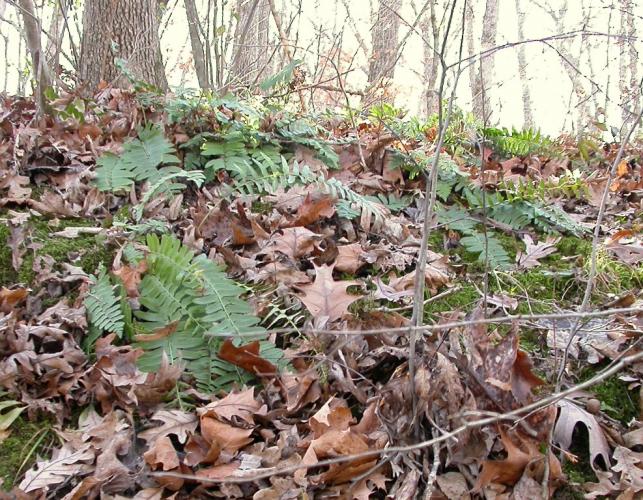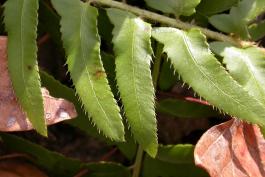
Christmas fern is a perennial fern that bears two types of leaves (fronds). Leaves that produce spores have the spore-producing leaflets (pinnae) at the upper third of the frond; these fertile leaflets are notably smaller and thinner than the vegetative (non-spore-producing) leaflets on the basal portion of the frond. The fertile leaves usually stand more upright than the sterile leaves, and their smaller, spore-bearing leaflets usually wither by winter. The sterile leaves, lacking spore-producing pinnae, have a more regular appearance and are evergreen, lasting through the winter, often lying flat on the ground. The leaf stalks are green and have scales (they are not shiny). In spring, the fiddleheads (developing fronds) are scaled and silvery.
Looking more closely at the leathery, rich green leaves, the lance-shaped leaflets are spiny-toothed with bristle tips, looking something like holly leaves. Leaflets usually have an earlike lobe at the base of the upper side. The spore clusters are in rows of circular, umbrella-like structures, which can be so close together that they may cover nearly the entire leaflet undersurface. Spores are produced June–October.
Habitat and Conservation
Life Cycle
Human Connections
Pioneers used the holly-like evergreen leaves of this fern to make Christmas wreaths, hence the name.
In cultivation, Christmas fern provides winter interest in woodland, shade, or native plant gardens, along walls, or on slopes. On slopes, it helps to prevent erosion. If you wish to plant Christmas fern, make sure you get your plants from reputable native plant dealers. Don’t dig them from the wild.
Ferns and their relatives dominated the landscape in the Carboniferous Period, about 300 million years ago. Through geologic processes, they, and the carbon they had taken from the air and trapped in their tissues, were transformed into coal. In a way, the coal we burn for energy is a plant resource — fossilized fern forests. When we burn coal, we are taking carbon that had been buried underground for millions of years and releasing it back into the atmosphere.
Ecosystem Connections
During winter, the prostrate fronds of Christmas fern hold fallen leaves against the ground, speeding their decomposition and enriching the soil.
Christmas ferns and other plants help to stabilize soils on slopes, preventing erosion.
Not many animals eat the leaves of Christmas fern.
Like other evergreen plants, Christmas fern can conduct photosynthesis on warm winter days. Also, it can take advantage of sunny days in early spring and late fall, when leafless trees permit sunshine to reach the forest floor.













































